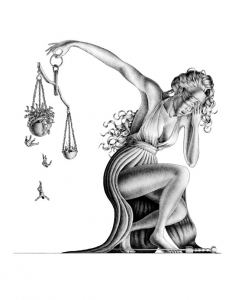Technology Now Fixes the Things that are Broken with our Legal System

Do we all have equal access to justice? It depends. Can you afford to hire a great lawyer? Is your income low enough AND can you fit the other narrow parameters to qualify for a free attorney? Do you know an attorney who is indebted to you for thousands of dollars and will represent you? Maybe you were a lawyer in a former life and can represent yourself in court (and binge-watching Law & Order on Netflix does not count). If you answered no, you probably don’t have equal access to the court system. What do you do? Some people choose to do nothing, and walk away from the problem, but what if you want access to the legal system?
Our legal system in a nutshell—it’ll make you crazy.
Our court system is a labyrinth that often places form over substance. Technical requirements of the court system prevent individuals from effectively representing themselves. Businesses are actually prohibited by law from doing so. It is almost impossible to effectively handle a case in court without hiring an attorney.
Let’s use a simple example of a roof that is installed and leaks. From the perspective of a plaintiff, the damaged party, you have a lot of questions to answer. First, you must determine the nature of your claims. Is it a breach of contract? Negligence? Defective product? What do you have to prove to succeed on these claims? How long do you have to sue? Wait—who do you sue? The person who installed the roof? The company? What is the company’s legal name? These questions are a fraction of the issues that arise when you are the plaintiff in a lawsuit.
Options that aren’t very good options.
How can you successfully get through the court process if you can’t afford a great lawyer? Some have suggested that law students can provide assistance. The obvious problem is that law students don’t know much. Proceeding with a bad or inexperienced lawyer may be worse than having no lawyer. There was a client who had a default entered against him when his lawyer failed to show up for a hearing. The judge refused to vacate the default because he had previously warned the client to get a different attorney. The problem was that the client couldn’t afford a different attorney.
Other alternatives include having someone at the courthouse provide some basic guidance on the process, or having judges help more in the courtroom. These ideas have their own problems. Judges and court staff can be reluctant to provide advice, and may even be prohibited from doing so. These solutions are myopic because they exist only inside the courthouse. Frankly, no one wants to go through the process of even parking at the courthouse.
Alternative Dispute Resolution—a name only a lawyer can love.
“Alternative Dispute Resolution” generally refers to either mediation or arbitration. Mediation is simply a meeting with an objective third-party, or mediator, who tries to negotiate an agreed settlement between the parties to a dispute. The mediator may or may not be a lawyer. The mediator may or may not be familiar with the law governing your dispute. The mediator will likely charge an hourly rate for the mediation (unless your court system has a free program for mediation in which case your mediator may not be a lawyer, may not be familiar with the law governing your case, and may be in a hurry to get back to his/her paying job). Mediation can be helpful in that, if done correctly, it may educate the parties on the strengths and weaknesses of their case and help the parties reach a compromise. There are, however, multiple problems (in addition to the ones mentioned above) with mediation. For example, mediators are generally trying to work out a compromise resolution—not necessarily the correct resolution. This means that if you are the weakest link, then you’re going to give up more to reach a compromise than the bully sitting in the next room who is demanding that your damaged roof is worth only $0.01.
Arbitration is another method of alternative dispute resolution, but generally one that only very wealthy individuals or large companies could historically access. Traditional arbitration is like having a private trial. The parties select an arbitrator who acts as the judge, reviews the evidence, and decides. The formal rules of evidence are typically relaxed and there may not be any discovery conducted in the case. Typically, the arbitrator is a lawyer, being paid a regular hourly rate to act as the judge. Sometimes, an arbitration may even have a panel of arbitrators.
Technology saves the day.
People just don’t know what to do when they have a legal dispute. How would they? The system is so complicated that lawyers and judges often have difficulty understanding it. It’s not a level playing field, and let’s not even get started on the unconscious bias that you may suffer when you walk into the courtroom (“Am I too black, too Muslim, too female, too old?”).
Here’s a solution virtually everyone can access: online arbitration for a flat fee. This allows any person or company to submit a legal dispute to arbitration. Both sides of the dispute provide their information (“evidence”). You upload submissions from your computer or cell phone. The arbitrator reviews the information and decides. No appearing in court, no stress of the court system, and no multi-year litigation. Plus, there’s no bias against you when you walk into the courtroom.
Technology has allowed advancements in so many areas of our lives. We went from taxis to Uber; from hotels to Airbnb; and from venture capital funding to crowdfunding. Times are changing and technology is making things faster, less expensive, and more accessible. The use of technology for online arbitration just fixed the problems most people and businesses experience with our legal system.
 Pansy Moore-Shrier is the founder of Two Goats Solutions Inc., a company working to provide individuals and businesses a better way to resolve legal disputes. She is also an attorney who is passionate about making the world a better place and helping people have access to justice.
Pansy Moore-Shrier is the founder of Two Goats Solutions Inc., a company working to provide individuals and businesses a better way to resolve legal disputes. She is also an attorney who is passionate about making the world a better place and helping people have access to justice.
